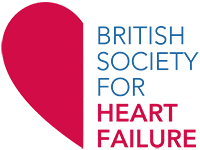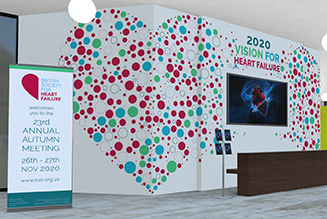New perspectives in heart failure management and the development of the multidisciplinary workforce was the focus of the 23rd Annual Autumn Meeting of The British Society for Heart Failure (BSH) ‘2020 vision for heart failure’. Held on 26th–27th November 2020, the meeting was hosted for the first time in a virtual space, which resembled the traditional home of the conference, the QE II Centre in London. Dr Alexandra Abel reports selected highlights from the meeting.

Clinical trials update
Heart failure (HF) management in the 21st century was discussed by Professor John McMurray (University of Glasgow). We are fortunate to have evidence-based medications for HF with reduced ejection fraction (HFrEF): angiotensin-converting enzyme (ACE) inhibitors, beta blockers, mineralocorticoid receptor antagonists (MRAs), angiotensin receptor-neprilysin inhibitors (ARNIs); and now the rise of sodium glucose co-transporter 2 (SGLT2) inhibitors. Key messages from two studies with SGLT2 inhibitors – dapagliflozin in DAPA-HF1 and empagliflozin in EMPEROR-Reduced2 are: SGLT2 inhibitors reduce the risk of HF hospitalisation and cardiovascular death and improve (and prevent worsening) renal function.
The benefits are seen on top of current guideline-recommended therapy. Professor McMurray proposed that we should move away from the vertical chronological initiation of HF therapies (i.e. titrate to full dose of an initial therapy, then add the next in line) to maximising the ease and speed of drug initiation and up-titration, remembering that time is of the essence with prognostically beneficial medications.
An update on HF clinical trials was given by Professor Andrew Clark (Castle Hill Hospital, Hull). It is a remarkable achievement that comprehensive therapy (ARNI, beta blocker, MRA, SGLT2 inhibitors) versus conventional therapy (ACE inhibitors, beta blockers) for HFrEF improves survival free from hospitalisation by 8.3 years for a 55-year-old and 2.7 years for an 80-year-old patient.3 Professor Clark said results from the recently reported SCORED4 and SOLOIST-WHF5 trials using the SGLT1/2 inhibitor sotagliflozin signal that SGLT inhibition could be of benefit in HF with preserved ejection fraction (HFpEF), and is being investigated further in the EMPEROR-Preserved and DELIVER studies. Other notable trials from the year were GALACTIC-HF6 with omecamtiv mecarbil, a cardiac-specific myosin activator, and VICTORIA7 with vericiguat, a soluble guanylate cyclase stimulator. Both showed modest effects and may have niche roles in the management of HFrEF.

Senescence in HF
Best practice in treating HF in older people was discussed by Professor Jackie Taylor (Glasgow Royal Infirmary). The median age of patients at first HF admission is 80 years, so older people make up a significant proportion of the HF population. It will reassure us, personally and professionally, to know that age is just a number: those who are ‘biologically fit’ (the Mick Jaggers of the world) need not be treated any differently to their younger counterparts and should have access to the same evidence-based drug and device therapies. In DAPA-HF, outcomes for those aged 75 years or older were just as good, if not better, than their younger counterparts. Professor Taylor emphasised that it is important to differentiate patients who are biologically fit from frail patients, who are at high risk of poor outcomes and would benefit from a holistic comprehensive geriatric assessment.
The prevalence of frailty in HF is approximately 45% and frail patients may have different goals of therapy – polypharmacy, for example, is common and undesirable in frail older patients. Professor Taylor set out her top tips for pharmacotherapy:
- undertake a medication review (stop all unnecessary pills and potions)
- start low and go slow with prognostically beneficial medication (the maximum tolerated dose may not be the target dose and it is better to be on small doses of each than a higher dose of one)
- use the lowest dose of diuretic for euvolaemia and maximise patient convenience.
Useful criteria for optimisation are the STOPP (Screening Tool of Older People’s Prescriptions) and START (Screening Tool to Alert doctors to Right Treatments).
In the management of HF in older people, Professor Taylor said it is helpful to consider four domains:
- medical (evaluate aetiology, review medication, consider co-morbidities)
- mind and emotion (evaluate cognition, screen for depression)
- physical function (screen for frailty, evaluate mobility and fall risk)
- social environment (ask about social support at home).
It is important to take an individualised approach to HF management: ultimately, the goals of therapy should reflect what matters most to the patient. This can be maximising quality of life, functional capacity, and independence.
The middle child of HF
An engaging lecture on HF with mid-range ejection fraction (HFmrEF) was delivered by Professor Carolyn Lam (National Heart Centre, Singapore). Dubbed the ‘middle child’, HFmrEF is defined as a left ventricular ejection fraction (LVEF) of 40–50%. Professor Lam quipped that the ‘older child’ (HFrEF) gets all the awards i.e. large randomised controlled trials (RCTs), the ‘younger child’ (HFpEF) gets all the love i.e. new trials, while the ‘middle child’ (HFmrEF) seems to get no attention or recognition. HFmrEF, however, represents a significant proportion of patients (approximately 15% of those hospitalised for HF). Moreover, approximately a third of patients with HFmrEF will drop their LVEF and move into HFrEF.
But how should HFmrEF be managed in clinical practice? Retrospective analyses of RCTs indicate that patients with HFmrEF benefit from the prognostically beneficial therapies used in HFrEF. Data from the PARAGON-HF8 and PARADIGM-HF9 studies analysed by LVEF show a benefit in the mid-range; and women seemed to gain benefit up to a higher LVEF than men. Because women have a higher overall LVEF, at the 50% point, they may already have systolic dysfunction. Professor Lam therefore believes that it is time to rename the middle child of HF from ‘mid-range’ to ‘mildly reduced’ to prompt practitioners to consider use of neurohormonal therapies, particularly in women.
HF with recovered ejection fraction
Professor Lam also discussed the concept of HF with ‘recovered’ ejection fraction (HFrecEF), defined as:
- a documented LVEF <40% at baseline
- ≥10% absolute improvement in LVEF
- a second measurement of LVEF >40%.
In TRED-HF,10 those patients with recovered dilated cardiomyopathy who had their HF treatment withdrawn had a high risk of relapse. Therefore, guideline-directed therapy for patients with HFrecEF should be continued indefinitely until this clinical state is better understood.
HF and failing kidneys: what are the priorities?
Clinical cases in cardiorenal syndrome (CRS), were discussed by Dr Will Petchey (West Suffolk Hospital, Bury St Edmunds). In patients with acute HF, approximately a quarter have acute kidney injury (AKI) and half have chronic kidney disease. The presence of renal impairment carries a poor prognosis – mortality is increased two-fold. Dr Petchey presented the case of a 79-year-old man with CRS who had been referred for palliative care after not responding to furosemide 240 mg daily over a month as an inpatient. He was started on metolazone 2.5mg twice daily and furosemide 480 mg twice daily. He made a dramatic improvement and was able to spend several months at home with family before his death (from pneumonia). Dr Petchey said we are often not aggressive enough with diuresis and should always consider the pre-admission dose.
The DOSE-AHF study compared treatment with IV diuretics equivalent to pre-hospital dose versus high dose (double dose) therapy in patients with acute HF.11 On high dose therapy, there was greater reduction in dyspnoea, 30% higher diuresis, and 31% (vs. 17%) step-down rate to oral therapy. Although there was more AKI in the high dose group, creatinine at 60 days for both groups was similar. In CARRESS-HF, renal function even improved with aggressive diuretic therapy (highest dose: furosemide 800 mg twice daily in addition to metolazone 5 mg twice daily).12 Aronson et al. found that patients with acute HF who develop transient worsening renal function (back to baseline by day 30) have the same outcome as those with no change in renal function.13 AKI should therefore not be a barrier to effective HF treatment. Dr Petchey likes to treat his patient with what he calls ‘MICLO’: masterful inactivity and cat-like observation!
Dr Petchey’s key messages were:
- use appropriate and effective doses of diuretics (have courage!)
- accept an initial rise in creatinine with effective treatment
- regularly review response (ask: is another diagnosis plausible?)
- although the evidence does not support routine use of ultrafiltration in HF, in selected cases, individual patients may benefit (discuss with your nephrology team).
Growing roles for nurses and allied health professionals
Ms Jane Draper (Guy’s and St Thomas’ NHS Trust), lead clinical scientist for heart failure and inherited cardiac conditions, shared her experience of running clinical scientist led cardio-oncology clinics. Echocardiography is fundamental to cardio-oncology and clinical scientists have expert skills in this area. Patients at risk of cardiotoxicity are referred to the clinic, where they are reviewed and have 3D echo with strain imaging. The key benefit is that echo is interpreted and acted upon in clinic. The outcome is communicated to the patient and the oncology team so there is a clear plan for whether the patient should continue chemotherapy. Confirmed cardiotoxicity results in a same day discussion with a consultant cardiologist, initiation of medication as indicated, and referral to the nurse-led rapid up-titration clinic. Ms Draper explained that the clinics led by clinical scientists had been prompted by pressures relating to the COVID-19 pandemic, but they had been successful in providing a multidisciplinary ‘one stop shop’ service that has reduced delays in cancer treatment.
Nurses and allied health professionals (AHPs) make a vital contribution to HF care, often leading the delivery of local services, but are under-represented in research. Dr Claire Lawson (University of Leicester), advanced NIHR research fellow, cardiology nurse and lecturer, outlined key research areas in which nurses and AHPs have engaged: big data (risk groups, outcome variation), organisation (case management, HF clinics, MDT interventions), self-care (tele-health), and intervention (education, exercise). Dr Lawson said there is evidence that research-active nurses and AHPs provide better care and improved patient outcomes. However, there is a lack of defined job roles for those who have undertaken clinical academic training.
Dr Lawson advised finding a supportive mentor who is familiar with the fellowship schemes available i.e. programmes offered by the National Institute for Health Research (NIHR) and British Heart Foundation (BHF). The BHF has also funded the development of the Clinical Research Collaborative (CRC) https://bhfcrc.org/, which works with affiliated groups of the British Cardiovascular Society to develop their own research forums – the British Association for Nursing in Cardiovascular Care (BANCC) https://www.bancc.org.uk/pages/default.asp, for example, has held its first CRC forum meeting. Dr Lawson emphasised the importance of the research-active multi-professional team and invited nurses who wish to engage with BANCC to get in touch via email: bancc@bcs.com.
Professor Paul Kalra (Portsmouth University Hospitals NHS Trust), Past Chair of the BSH, emphasised that the BSH would like to encourage nurses and AHPs to apply for the Early Investigator Award.

The Early Investigator Award 2020
The 2020 Early Investigator Award received 16 applications, from which three candidates were chosen to present their work: Dr Joe Cuthbert (Hull), Dr Natalie Mordi (Dundee), and Dr Will Watson (Oxford).
Dr Joe Cuthbert presented his work on the clinical significance of changes in chloride levels in patients with acute HF. In his study of 963 patients hospitalised with acute HF, those with hypochloraemia on discharge (persistent or incident) had a higher mortality at one year compared with those with normal chloride. Conversely, those whose chloride level recovered during admission did not have a worse prognosis. Dr Cuthbert posited that chloride is not merely a marker of adverse outcome; it may be a mediator. If so, hypochloraemia could be a therapeutic target in HF and present an opportunity for the use of pharmacotherapies, such as acetazolamide.
Dr Natalie Mordi presented her work from RECEDE-CHF: a randomised, double-blind, crossover trial of empagliflozin 25 mg once daily versus placebo in combination with loop diuretics in 23 patients with type 2 diabetes and chronic HF.14 Patients taking empagliflozin experienced a significant increase in 24-hour urine volume, no significant change in natriuresis, significant reduction in weight and loop diuretic requirement, and an increase in electrolyte free water clearance. Dr Mordi’s study suggests that empagliflozin augments the diuretic response in patients with type 2 diabetes and chronic HF taking regular loop diuretics.
Dr Will Watson presented his work on myocardial energy metabolism using GTN in 10 healthy participants as a model for the haemodynamic stress faced by the heart in, for example, sepsis. The fall in preload with GTN means that cardiac output can be maintained only by (endogenous) positive inotropy and thus extra energy consumption. Using magnetic resonance spectroscopy and imaging, Dr Watson was able to show that the GTN resulted in a huge increase in creatine kinase activity and a small decline in the ratio of phosphocreatine (PCr) to ATP. Since high energy phosphate is transported from mitochondria to site of use via PCr, mediated by phosphocreatine, the decline in the PCr:ATP ratio implies depletion of high energy phosphate supplies. Metabolic modulators that enhance phosphocreatine production might prevent energy depletion and possibly stress-related HF.
Following three excellent presentations, congratulations go to the winner Dr Mordi (renal and general medicine registrar, Ninewells Hospital, Dundee; BHF clinical research fellow) and her team at the University of Dundee. Dr Mordi is writing her doctoral thesis on renal sodium handling in the presence of SGLT2 inhibition and the effect of co-prescription with loop diuretics.
The Lynda Blue Award 2020
The inaugural Lynda Blue Award – for a health professional who has demonstrated excellence in HF care – honours the memory and legacy of Lynda Blue, a beloved colleague and pioneer in nursing and multidisciplinary care in HF. The winner was announced as Mrs Jayne Masters , lead HF specialist nurse at University Hospital Southampton NHS Trust. Mrs Masters worked with Lynda Blue to set up the BSH Nurse Forum https://www.bsh.org.uk/nurse-forum/ and is dedicated to the development of HF nurse specialists locally and internationally. Congratulations to Mrs Masters: we would like to thank her for her tenacity, compassion, and commitment to patient care.
Watch meeting
All presentations from the meeting are available for BSH members to view at: https://www.bsh.org.uk/content-restricted/bsh-autumn-meeting-archive-2020/
If you want to become a member of the BSH visit: https://www.bsh.org.uk/become-a-member/
Diary dates
22nd April 2021: BSH Research Investigator Meeting
21st May 2021: BSH Nurse and Allied Health Professionals Training Day
3rd-4th December 2021: BSH 24th Annual Autumn Meeting
Further information about the BSH and its events can be found at www.bsh.org.uk
Acknowledgements
The BSH thanks the ‘Friends of the BSH’ for their support in the activities of the society.
AA thanks Professor Andrew Clark for his advice.
Conflicts of interest
None declared.
Alexandra Abel
Academic FY2 research fellow
Academic Cardiology, Castle Hill Hospital, Kingston upon Hull
(Alexandra.abel@hey.nhs.uk)
References
1. McMurray JJV, Solomon SD, Inzucchi SE, et al. Dapagliflozin in patients with heart failure and reduced ejection fraction. N Engl J Med 2019;381:1995–2008. https://doi.org/10.1056/NEJMoa1911303
2. Packer M, Anker SD, Butler J, et al. Effect of empagliflozin on the clinical stability of patients with heart failure and a reduced ejection fraction: The EMPEROR-Reduced Trial. Circulation 2021;143:326–336 https://doi.org/10.1161/CIRCULATIONAHA.120.051783
3. Vaduganathan M, Claggett BL, Jhund PS, et al. Estimating lifetime benefits of comprehensive disease-modifying pharmacological therapies in patients with heart failure with reduced ejection fraction: a comparative analysis of three randomised controlled trials. Lancet 2020;396:121–8. https://doi.org/10.1016/S0140-6736(20)30748-0
4. Bhatt DL, Szarek M, Pitt B, et al. Sotagliflozin in patients with diabetes and chronic kidney disease. N Engl J Med 2021;384:129–39. https://doi.org/10.1056/NEJMoa2030186
5. Bhatt DL, Szarek M, Steg PG, et al. Sotagliflozin in patients with diabetes and recent worsening heart failure. N Engl J Med 2021;284:117–28. https://doi.org/10.1056/NEJMoa2030183
6. Teerlink JR, Diaz R, Felker M, et al. Cardiac myosin activation with omecamtiv mecarbil in systolic heart failure. N Eng J Med 2020 (published online 13 November 2020 ahead of print). https://doi.org/10.1056/NEJMoa2025797
7. Armstrong PW, Pieske B, Anstrom KJ, et al. Vericiguat in patients with heart failure and reduced ejection fraction. N Engl J Med 2020;382:1883–93. https://doi.org/10.1056/NEJMoa1915928
8. Solomon SD, McMurray JJV, Anand IS, et al. Angiotensin-neprilysin inhibition in heart failure with preserved ejection fraction. N Engl J Med 2019;381:1609–20. https://doi.org/10.1056/NEJMoa1908655
9. McMurray JJV, Packer M, Desai AS, et al. Angiotensin-neprilysin inhibition versus enalapril in heart failure. N Engl J Med 2014;371:993–1004. https://doi.org/10.1056/NEJMoa1409077
10. Halliday BP, Wassall R, Lota AS, et al. Withdrawal of pharmacological treatment for heart failure in patients with recovered dilated cardiomyopathy (TRED-HF): an open-label, pilot, randomised trial. Lancet 2019;393:61–73. https://doi.org/10.1016/S0140-6736(18)32484-X
11. Felker MG, Lee KL, Bull DA, et al. Diuretic strategies in patients with acute decompensated heart failure. N Engl J Med 2011;364:797–805. https://doi.org/10.1056/NEJMoa1005419
12. Bart BA, Goldsmith SR, Lee KL, et al. Ultrafiltration in decompensated heart failure with cardiorenal syndrome. N Engl J Med 2012;367:2296–2304. https://doi.org/10.1056/NEJMoa1210357
13. Aronson D, Burger AJ. The relationship between transient and persistent worsening renal function and mortality in patients with acute decompensated heart failure. J Cardiac Fail 2010;16:541–7. https://doi.org/10.1016/j.cardfail.2010.02.001
14. Mordi NA, Mordi IR, Singh JS, et al. Renal and cardiovascular effects of SGLT2 inhibition in combination with loop diuretics in patients with type 2 diabetes and chronic heart failure: The RECEDE-CHF Trial. Circulation 2020;142:1713–14. https://doi.org/10.1161/CIRCULATIONAHA.120.048739
